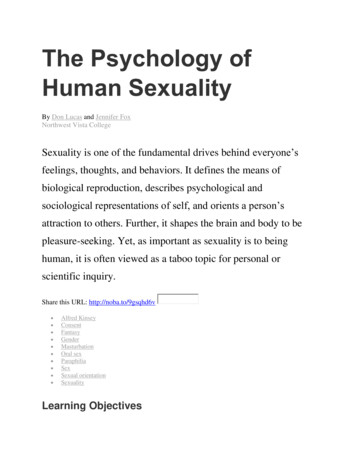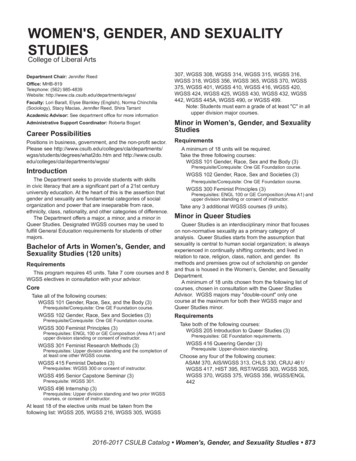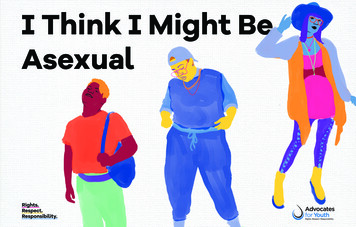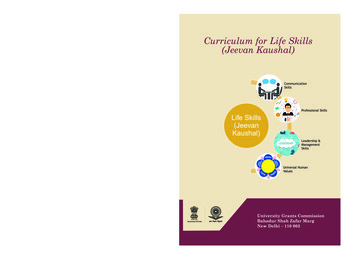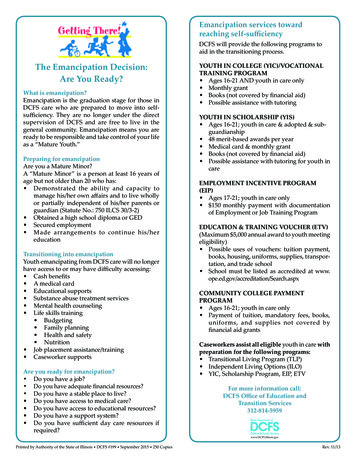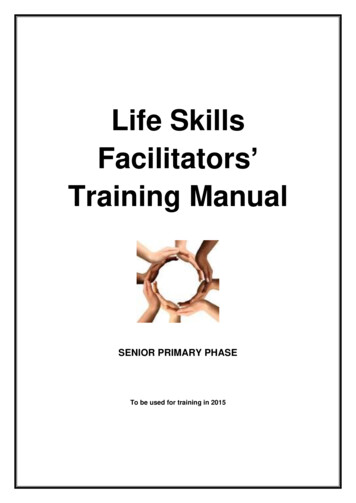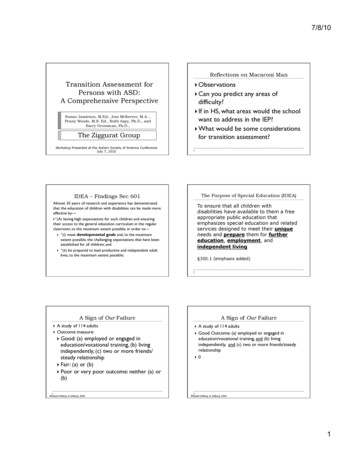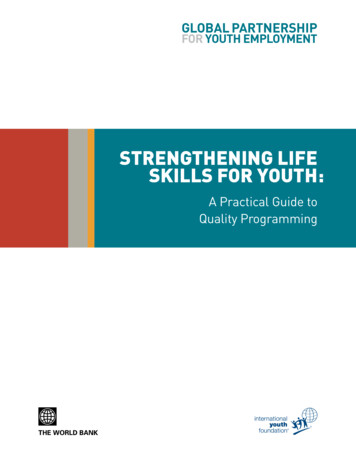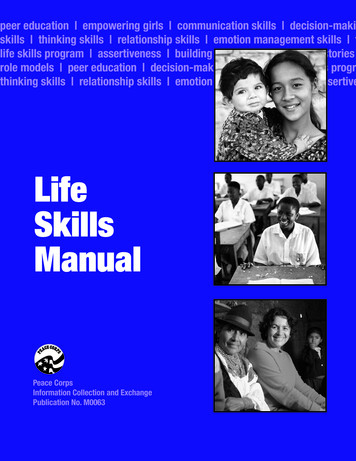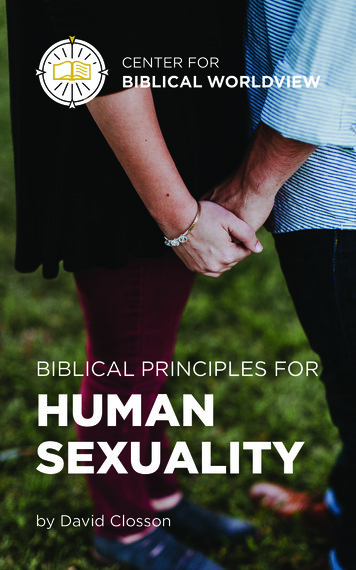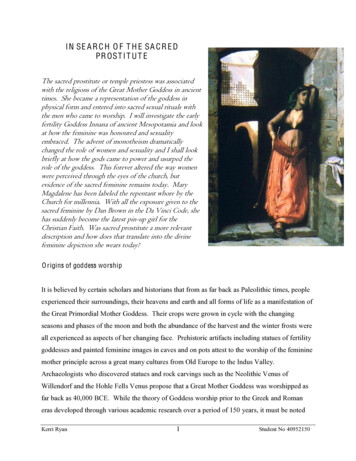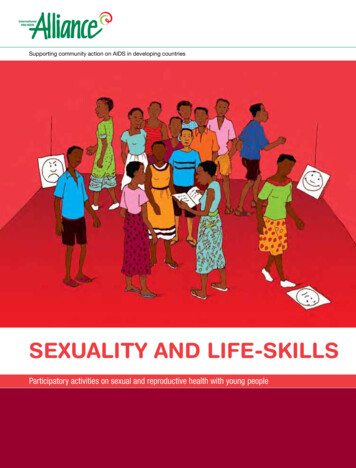
Transcription
Supporting community action on AIDS in developing countriesSEXUALITY AND LIFE-SKILLSParticipatory activities on sexual and reproductive health with young people
AcknowledgementsThis toolkit is the result of teamwork between sexual andreproductive health practitioners working with youngpeople in Zambia, Malawi, Zimbabwe and Uganda.The first version of the toolkit was developed withInternational HIV/AIDS Alliance, Planned ParenthoodAssociation of Zambia, Young, Happy, Healthy andSafe, the Ministries of Health and Education, and peereducators and young people in rural Eastern Province,Zambia. The toolkit was tested by peer educators andrevised on the basis of their experience and the lessonslearned in monitoring.The toolkit was further developed with the AllianceRegional Youth Programme partners in Zimbabwe,Malawi and Zambia, and with the CORE Initiativein Uganda.We wish to acknowledge the ideas and creativity of allthe practitioners who have developed the toolkit andthose who have been developing participatory activitiesover many years and in many countries. We do notknow the source of many of these activities but would tolike to acknowledge three resources in particular:Happy, healthy and safe: youth-to-youth learningactivities on growing up, relationships, sexual health,HIV/AIDS and STD life-skills. Family Health Trust Zambia(1998) Lusaka, Zambia.Choices: a guide for young people. Gill Gordon (2007)Macmillan Education, Oxford, UK.Stepping Stones: a training package on HIV/AIDS,communication and relationship skills. Alice Welbourn(1995) Strategies for Hope.The production of this publication was made possiblethrough the support of Comic Relief, The Morel Trust,DANIDA, Sida and BUZA. The opinions expressedherein do not necessarily reflect the views of thesedonors. International HIV/AIDS Alliance, 2008Registered charity number 1038860Information contained in this publication may be freelyreproduced, published or otherwise used withoutpermission from the International HIV/AIDS Alliance.However, the International HIV/AIDS Alliance requeststhat it be cited as the source of the information.Illustrations Petra Röhr-Rouendaal 2008Designed by Jane Shepherd, UKPrinted by Dexter Graphics, UKPublished: February 2008ISBN: 1-905055-44-7
CONTENTSTrust and confidentialityINTRODUCTIONUsers and aims of the toolkit4What do young people need to learn aboutsexuality and life-skills?5Guide to using the toolkit6How to use the activities8Activity record sheet12Course 22Introduction to sexuality and life-skills14Introductions and hopes and fears16Trust17Working together18Ground rules19Listening pairs20Body language21I’m OK, you’re OK22How we are the same, how we are different23The road of life and possible futures24Puberty – physical changes26Menstruation28Wet dreams31Developing from a child to an adult33Growing up as a boy and as a girl35What we think is right for boys and girls37Where do we get our ideas from?39What do boys and girls think and feel?42Friendship between boys and girls44What is love? And how good a friend am I?46Saying what we want and how we feel48Ways to stay strong521
Trust and 36373839404142434445464748495051522Making decisions54Keeping to your decision56Sexuality throughout our lives58Respect59Talking with adults about sex62Shall we have sex or not?65Saying ‘No’ to sex until I am ready67Helping ourselves71Understanding our bodies and feelings74The quiz78Talking about our feelings and sexuality80Sexual friendships with the same sex81Having a happy sex life83Let’s use a condom85Having sex only with each other92Early marriage94Having sex with older people97Using sex to get on in the world99Income generation102Understanding and fighting corruption103Human activity as a way to alleviate poverty 104Good touch, bad touch105Protecting ourselves from rape109What to do if someone is abused or raped111Solving problems112Children by choice, not chance115Taking responsibility for pregnancy120Coping with teenage pregnancy122Sexually transmitted infections124Getting proper treatment for STIs128
CONTENTSTrust and ng ourselves from STIs129Protecting ourselves from HIV infection132How is HIV transmitted in the community?137Journey of hope and future islands140Living with HIV infection142Prevention of parent-to-child transmission146HIV stigma and discrimination148HIV and human rights153Drug use and abuse156Coping with anger159Our feelings and responses to criticisms162Violence164Conflict resolution167RESOURCES1693
INTRODUCTIONUsers and aims of the toolkitThis toolkit is written for anyone who wantsto facilitate participatory learning activitieswith young people to equip them with theknowledge, positive attitudes and skills to growup and enjoy sexual and reproductive healthand well-being. This includes peer educatorsand leaders, outreach workers, teachers,community workers and others.It aims to assist facilitators to: provide accurate and complete factualinformation to young people plan appropriate educational activities forgroups of young people that enable them to: analyse their own situations, resourcesand needs apply new knowledge to their own lives increase awareness of their own valuesand attitudes develop their self-esteem and confidence develop life skills, for example,communication and assertiveness skills,problem-solving and decision-making build trust and take collective action as agroup. follow up and evaluate their work.The educational approach tobehaviour change used in thetoolkitExperience has shown that education whichhas a positive impact on attitudes andbehaviour has the following characteristics:It is a two-way learning process betweenequals that starts from what people alreadyknow and feel. Everyone is respected andvalued, whatever their age and sex.People actively learn through participatoryproblem solving activities related to their ownlives. They experience a new way of doing4things or how it feels to be in someone else’sshoes and this changes them.People develop positive values and behaviourthrough exploring options, understanding thedifferent influences on their lives and coming totheir own views and decisions, rather than beingtold what to do.In order to adopt healthy sexual behaviour,young people need to have accurateinformation (key facts), opportunities to applythis to themselves (values and attitudes) andto feel good enough about themselves to thinkthat they are worth looking after (self-esteem).Then they need the skills to act on their newunderstanding.Young people are more likely to adopt healthybehaviours if they see that this will have apositive effect on their lives than if they areasked to give up something to avoid a badconsequence.For example, young people are more likely toavoid smoking if they believe that this will makethem play football better or be more attractivethan if they are told to stop because they mightdie of lung cancer some time in the future.The education is based on the reality of youngpeople’s lives, their opportunities and difficultiesand the choices open to them.The education is based on internationally andnationally agreed rights of the child, of womenand of human beings in areas of sexual andreproductive health.
INTRODUCTIONWhat do young people needto learn about sexuality andlife-skills?People worry that if we teach young peopleabout sexuality, it will encourage them to starthaving sex early. The evidence shows sexeducation either has no effect or young peopledelay sex for longer and when they do start,they are more likely to protect themselves frompregnancy, STIs and HIV.Abstinence before marriage, and lifelong fidelitywithin it is the moral ideal of many religions.Many people promote this ideal to reduce thespread of HIV. However, some young people areborn with HIV and, although we may try our bestto have good and safe sexual relationships, ourlives are complex and we do not always achieveour goals. This puts us at risk of HIV and otherproblems. For example, many young womencontract HIV in their first year of marriage froman older spouse who had sex before. This is whywe need to be open our relationships and ableto access HIV testing and condoms.The danger of setting such difficult targets is thatwhen we fail, we feel bad and keep it a secret.We blame others who fail, including those withHIV. This often leads to people hiding what isgoing on and feeling unable to take actionssuch as going for testing or using condoms. Inthis environment, condoms are often seen asa device only for people with bad morals andpeople are reluctant to obtain them or suggestusing them. This toolkit aims to reduce damagingbehaviour and feelings such as blame, shame,guilt, stigma and discrimination caused byjudging and labelling sexual behaviours that donot match the moral ideal.In this toolkit we say that abstinence is thesafest choice for young people, but they willgrow up and at some point become sexuallyactive. We cannot afford to wait until they do,nor can we afford not to equip them with theinformation they need to protect themselves.Up-to-date information on sexual andreproductive health needs to become a partof the sexual culture of our societies, taughtthrough school and community teachers.Sexuality is a sensitive issue for all of us. Newand controversial issues are being talked aboutin our countries and in this toolkit. Sometimeswe find it difficult to face the reality and toimagine how things could be different. Weare afraid that our culture will be destroyedby outside influences. However, our cultureis always changing – things are different foryoung people now than they were for pastgenerations. An important life-skill is criticalthinking about the things that influence ourbehaviour. Then we can strengthen the helpfulparts of our culture, change or remove harmfulones and add some new ideas.Our ultimate aim is to help young people togrow up happy, healthy and safe. This meansseeing the reality and working together toimprove things within that reality as well asworking for positive change.Working with parents, guardiansand community membersYoung people cannot improve sexual andreproductive health alone. They need thesupport of friends, families, service providersand the wider society. If they meet in groups,they can support each other in positive waysand take actions together to improve things.If they make strong partnerships with others,they can get support to make the community asafer place for everyone.Parents and carers would often like toteach their children more about sexual andreproductive issues but they may need moreinformation themselves, more confidence andapproval from the society.Adults will also learn a lot from the topics andactivities in this toolkit. If they learn alongsidetheir children, it will bring many benefits toboth generations in increased knowledge,helpful attitudes and life-skills. This willencourage good relationships and safer sexualbehaviour.5
INTRODUCTIONIf parents learn to praise more and criticiseless, to be good role-models to their children,to teach with love and to critically think abouttheir changing cultural norms, then they canstrengthen the socialisation that they already do.As facilitators, you might want to use thistoolkit in the same way as the Stepping Stonesprocess (see Resources at the back of thistoolkit). In this process, older men and women,young men and women and boys and girlsmeet in peer groups and learn each topic at thesame time. They sometimes come together toshare what they have learned and discuss howthey want to change. At the end of a series ofmeetings, the peer groups make a request tothe whole community to change.Guide to using the toolkitPlanning your sessionsThe toolkit contains topic sessions with aims,key facts and a number of different activities.You need to plan each session with its aims,key facts and activities before you start.Always begin meetings with a new group withintroductions, trust, working together, groundrules and listening. This will help people to staysafe and feel comfortable.In some topics in the toolkit, you will find a‘Take care!’ note for the facilitator, to help youavoid hurting or offending the group.Decide on the age and sex of your groupand the amount of time that you have for thesession. For example, in our programme, peereducators hold regular sessions of about 90minutes with single sex groups in three agebands, 9-12, 13-17 and 18-24 years. Also thinkabout what materials you have available; forexample, paper and pens or beads.Select topics and activities that meet theinterests and needs of your different age andsex groups. Spend time in the first sessionfinding out from the group what they would liketo learn about. What questions do they have? Ifpeople are shy to ask their questions, ask them6TimingYou need to select aims, facts and activitiesthat you can realistically cover thoroughlyin your agreed time. Do not try to covertoo much. Everyone in the group needs tounderstand the topic thoroughly and havea chance to explore their feelings about itand develop skills. Group activities takelonger than giving facts in a lecture. Peoplework at different speeds, so we cannot sayexactly how long an activity may take.However, as a rough guide, a session willhave:Introductions and warm-up game15 minutesActivity45 minutesSummarising learning and key facts20 minutesEvaluation10 minutesIn some sessions, you may want to providesome facts first and then do the activity.Most of the activities involving role-play,stories, pictures and debates will take 30to 45 minutes to do. A few activities maytake longer. For example, the HIV infectiongame.to write them on slips of paper and put themin a bag or box anonymously. Those who canwrite can help those who cannot.People in the three age groups have differentneeds because of their different stages ofdevelopment. Males of different ages havedifferent needs to females.For example, girls of 9-14 years will needdetailed information on how to managemenstruation, while boys of the same age maybe worried about wet dreams. Many young
INTRODUCTIONpeople aged 18-24 will already be sexuallyactive or married and/or have children. Theymay be concerned about child-spacing andsexual happiness.Select activities that a particular age and sexgroup will enjoy. Ask them how they like tolearn, and evaluate their participation andinterest in different activities.Preparing for the sessiongame you need plastic bags or gloves andprepared slips of paper.Make yourself a plan for each session (seepage 13).Evaluating your sessionsEvaluation can tell us: how well we facilitated the session and howwe can improveRead the key facts before you start a session toget them clear in your mind. Keep your toolkitwith you in case you need to refer to it. Provideinformation as people need it throughout thesession. Use the facts to answer questions, tohelp people understand an activity and to addto their knowledge after the activity. what people have learned from the sessionIf an activity is new to you, try it out with afriend. If necessary, adapt the story or role-playto suit your group.We can evaluate the session in three ways:If you are going to use a resource person, meetwith her or him beforehand, go through thesession and the key facts, and agree on whowill do what and how long it will take.Ask yourself:What resources will you need?You and the young people that you work withare the best resources for learning. You cantalk, discuss, debate, perform role-plays andpractise new ways of saying things. All thesemethods help people to learn actively ratherthan just memorising facts.In most of the sessions, you will only needyourselves, your toolkit and a notebook torecord the evaluation of the session. Preparefor the session beforehand so that you haveeverything you need.If you are using activities with pictures, makesure that you have the right picture with you.If you are doing mapping or diagrams such asthe ‘But why?’ tree, you need a smooth areaof ground, soil or wall to draw on, some sticksand some objects such as flowers, leaves andstones to use as markers. For the HIV infection whether the topic and activity wasappropriate for the group what more they would like to learn how they have used what they learned intheir lives.1Self-assessmentWhat went well? What was difficult? What did Iachieve? How will I do it differently next time?2 ObservationIf you are working with another person, youcan take it in turns to observe how the groupis working together and responding to theactivities and discussion. If you are alone, youcan still observe how the group is respondingand working together. Watch out for thefollowing: How many people have come to themeeting? Who is actively participating and who iskeeping quiet? Who talks most and who talks least? Arepeople listening to each other? Are people working together or splitting offinto smaller groups? What is the mood of the group? Are peoplebored or interested? Is anyone upset orembarrassed?7
Trust andconfidentialityINTRODUCTION How do people respond when the peereducator does different things? Give feedback to each other after thesession.3Feedback from group membersInvite participants to tell you their views on thesession. You could go around and ask everyoneto say something, or invite people to call out ifthey want to say something.Feedback questionsFollowing up issuesIssues may arise in the sessions that requirefollow-up. For example, a participant may needcounselling or referral. They may want you toinvolve their family or friends. The group maybring up an issue that requires the involvementof other community members or serviceproviders. Try to make contact and collaboratewith resource people and service providers inthe community so that you can work with themto solve problems identified by the group. What is the most important thing that youhave learned in this session?How to use the activities How will you use what you have learned inyour own life? (if appropriate)The following suggestions aim to help you tofacilitate the activities in the toolkit in a safe,enjoyable and effective way. What did you enjoy most about this session? What did you find difficult?Working with groups What suggestions do you have for improvingthe next session?Try not to have more than 15 people in onegroup. Divide into smaller groups or pairs todiscuss sensitive topics. What questions or issues would you like tocover in the next session? If appropriate, you could ask people at thenext session how they were able to use whatthey learned in the previous session. You could ask them to respond to questionswith body language. For example,Ask people how interesting they found thesession. If they found it very interesting, theyput their hand up and wave. If they found itinteresting, they put their hand up; neitherinteresting nor boring, put hands in lap;boring, put thumb down; and very boring,put thumb down and waggle it.Or make an imaginary line on the groundwith one end ‘Very interesting’ and the other‘Boring’. Ask people to stand along theline according to how they feel about thesession.Start with groups of the same sex, especiallyfor sensitive topics. When people have gainedconfidence, mix boys and girls together toshare their ideas and get used to talking toeach other on these issues. Find ways thatyoung and older people can share their ideas.Do the activities in a place where peoplefeel comfortable, private and free frominterruptions.Always be aware that there are likely to bethose of us with HIV in the group or peoplewho have experienced the situation underdiscussion. Use language that includeseveryone, for example, say, ‘those of us withHIV’ instead of ‘people with HIV’ as if they aredifferent from us.Agree on how much time you will spendtogether. For example, 90 minutes is a goodperiod of time to cover a topic.Arrange the seating so that everyone feelspart of the group, able to make eye contactwith everyone and to talk and hear easily. Forexample, sit in a circle without desks.8
INTRODUCTIONTrust and confidentialityExplain that in this book people learn throughdiscussions and activities, rather than lectures.Each person has valuable ideas and peopleshould feel free to express their ideas andfeelings.Say that we all feel embarrassed at times whentalking about sexual matters. But this is essentialif we are to enjoy safe and happy lives. Pointout that because a person talks about sex doesnot mean that they are unusually free in theirbehaviour.Use games such as singing and dancing to helppeople to relax at the start of an activity or after adifficult topic.Agree on some guiding rules with the group. Thegroup could make pictures of these so that theycan be used at each session to remind peopleof their rules. Or the peer educator could writethem down and remind people if they forget. Inthe right-hand column is an example of guidingrules agreed by a group in Zambia.No question is stupid or not worthaskingAsk open-ended, probing and clarifyingquestions to encourage people to talk more fully.Put a box nearby so that people can write theirquestions anonymously.Focus the discussion and summarise so thatpeople can see what they have covered andwhere to go next.If you use a picture, make sure that everyonecan see it. Pass it around the group. Ask peopleto give the characters names and tell a storyabout them.If you are using a story, agony aunt letter, roleplay or picture to start a discussion, use thesequestions: What is happening in the story or picture? Does this happen to people like us? What are the causes and consequences ofthe situation?Our ground rulesWe will not talk about personal storiesand ideas that are discussed in the groupto people outside the group.We will speak one at a time and listen toeach other. Let’s begin by going aroundthe group and giving everyone a chanceto say something about themselves.We will help noisy people to quietendown and quiet people to speak.We each have a right not to participate.We will never pressure anyone to takepart in an activity or share personalinformation.We will respect each other’s right toour own opinions and values. We won’tjudge or ridicule people.We will take responsibility for challengingharmful prejudice and oppression inourselves and others.We all have a right to change our mindsand make mistakes. How could the characters solve the problemor what could the characters have done toavoid the problems?Role-playsIn a role-play, people act out a particularsituation. They may act as themselves or playthe role of another person. There is no writtenscript in role-play and the focus is on whathappens in the interaction, not how well people‘perform’ or act.Role-play is used as a basis for discussion; toincrease communication skills and self-esteem;to explore different situations and ways ofdealing with them; to express feelings openlyand see how others feel; to get inside other9
Trust andconfidentialityINTRODUCTIONpeople’s shoes and see how things feel fromtheir side and to rehearse for the future.In role-play, males can role-play females andvice versa. This experience helps males andfemales to understand each other better.How to use role-playInvolve everyone as participants with a role,or as observers. Ask people to volunteer forroles. Start in pairs or small groups with a fewobservers to build confidence. Encouragepeople to get into the role they are playing. Ifthey are playing a new character, have peopleask them questions about themselves to helpthem get into that person’s shoes. If they areplaying themselves in a new situation, theyshould respond as honestly as possible to thatsituation.Help the role-players to stay focused andexplore the situation fully. Most role-playscome to a natural pause. The best role-playsare fairly short, not more than 10 minutes atthe most.Tell the observers what to look for in the roleplay by giving them some questions.For example: What happened? Why did it happen? What did the characters feel? How did others react?After the role-play, give each of the players anopportunity to express their feelings about thecharacters and situations they portrayed. Thenask them to shed their characters and returnto themselves by removing any props, sayingtheir names and something about themselves.Then discuss what everyone learned from theexperience, analyse the role-play and discussits relevance to their lives. Talk about the roleplay positively in ways that increase the selfesteem of the players, especially if they havebeen brave enough to practise new skills and10deal with a difficult situation. Give praise first,before suggestions for improvement. Help withinformation and skills as necessary.Hot-seatingIn hot-seating, the players stay in role afterthe play. The observers ask them questions todeepen understanding of their motives, feelingsand situation. The observers can challengethem by asking why they behaved as they did,but not judge them.Forum theatreIn forum theatre, the role-play is shown once.It is then replayed from the beginning. Theobservers can clap and say ‘freeze’ to stop theplay at any point. They then ‘go into the shoesof’ one of the characters and change what theysay and/or do so that the situation goes better.The observers then discuss whether the newway worked well and whether it is realistic. Theplay then continues from where it was beforethe freeze.StoriesYou might use the stories in the toolkit indifferent ways. For example, read the storyaloud and then discuss it or role-play the storyor draw pictures of the different scenes. Youmight tell the story in the way that it is writtenand then retell it so that the characters avoidthe problems and have a happier life.Drawings and diagramsTry drawing and making some of the diagramsshown in the toolkit. For example, flow charts,maps and seasonal calendars. These methodsare called participatory learning and action(PLA) because they help people to shareand add to their knowledge, to analyse theirsituation, to plan and to act. Everyone can drawon the ground with a stick, on the blackboardor walls with chalk. The drawing does not haveto be professional because the creator canexplain what it means. Help everyone in the
Trust and confidentialityINTRODUCTIONgroup to pick up the stick and add their ideas.Use leaves, seeds, stones or sticks to markdifferent places or to score.Visits to health and other servicesIt can be very helpful for young people to visitlocal health services and talk with the nursesand family planning workers. It gives them anopportunity to ask questions and express theirconcerns, so that they feel more confident touse the services. Involve the whole communityin the use of the toolkit so that you get thesupport you need.Talking with people in thecommunitySome activities suggest that you talk withpeople in the community. For example, talk withparents and grandparents about how genderrelations have changed since their day. You canmake this go well by involving the communityin the activities and trying to get agreementon the needs of young people for sexual andreproductive health education.11
Trust andINTRODUCTIONconfidentialityActivity record sheet: Group meeting on sexuality and life-skills1. Details of group meetingDate of meetingLocation of meetingNumber of participantsType of participants (e.g. age and sex)2. Topic and activities covered during the meetingTopic(s) coveredActivities used3. What went well and what was difficult?What went well?What was difficult and how can we address this?4. What did we learn and how will we use this learning?5. Action points6. Date and time of next meeting and topics that we will cover at the next meeting12
What?Session titleKey factsWhy?Objectives andgroupCourse plannerWhen?Activity andDate and timeresources neededHow?LocationWhere?Peer motivatorsand resourcepeopleWho?EvaluationWhat effect?INTRODUCTIONTrust and confidentiality13
Introduction toTrustsexualityand confidentialityand life-skillsAims21 To introduce ourselves to the community. To explain the sexuality and life-skill programme. To find people who want to attend the meetings. To organise the next meeting.GroupCommunity members and young people want to know more aboutthe sexuality and life-skills programme.Time2 hoursi Key factsWhy have we organised this meeting?Introduce yourselves. Explain that you wouldlike to talk with the community about holdingsome meetings where people learn moreabout sexual and reproductive health andhow they can enjoy happy, healthy and safesexual lives as they grow up and as adults.We are all sexual beings from birth to death,even at times when we are not having asexual relationship. We are born and broughtup to behave as males and females. Later,we get together and make more boys andgirls. Sexual relationships are often difficult totalk about and make us feel shy. Yet this is anarea of life that is very important for all of us.We may learn about sexuality from ourelders, friends, families, school, books,magazines and films. We learn about growingup, relationships, being a man and a woman,pregnancy and how to avoid sexuallytransmitted infections.These days we also face an epidemic ofHIV, the Human Immunodeficiency Viruswhich causes Acquired Immune DeficiencySyndrome or AIDS. HIV weakens the immunesystem, which protects our bodies fromgerms. When the immune system is very14weak, we may suffer from a number ofdiseases – we have AIDS. Without treatmentmany us get very ill and die of AIDS.In Zambia and Uganda sexual intercourseis the main way that HIV is passed fromone person to another. For this reason,young people need to know how to protectthemselves from HIV from an early age. InZambia, evidence shows that young peoplehave a 50% chance of dying of AIDS in theirlifetime.There may be ten years when youngpeople have sexual feelings and perhap
Association of Zambia, Young, Happy, Healthy and Safe, the Ministries of Health and Education, and peer educators and young people in rural Eastern Province, Zambia. The toolkit was tested by peer educators and revised on the basis of their experience and the lessons learned in monito
